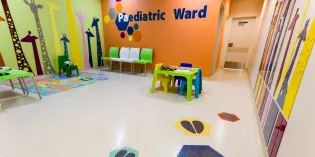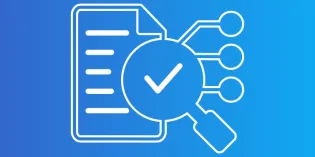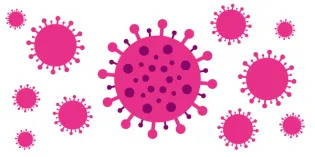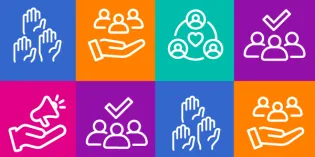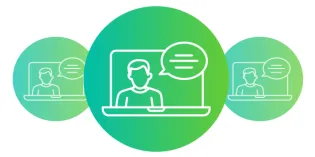Introduction
The RCPCH Digital Health Programme (DHP) has been recently established to promote digital ways of working in paediatrics and child health.
Key opportunities to support the paediatric workforce in adopting emergent digital health technologies include:
- raising awareness of the available safe and effective digital health solutions for paediatrics
- progressing digital capabilities across paediatric professions and disciplines
- minimising barriers to accessing technologies in healthcare.
These will be delivered through informative resources and advocating for the responsible use of digital health technologies.
The first task towards developing our learning resources is to obtain a baseline measure of RCPCH members’ views of digital health technologies, and understand where digital skills gaps remain in paediatrics. In late 2024 and early 2025 we ran two baseline surveys: digital health solutions and digital health skills.
This report outlines the background and results from the digital health solutions survey.
Survey background
The digital health solutions survey was distributed online to RCPCH members worldwide from November 2024 until March 2025. The aim was to gather which digital health solutions the survey respondents had used and what they sensed the impact might be in their paediatric practice now and in the future.
The survey was completed by 61 respondents, 45 of whom were based in the UK. The analysis has been conducted for responses received from RCPCH members in the UK. A summary of the results is outlined below for the UK respondents only.
There were three broad sections to the survey. Firstly, respondents were asked which digital health solutions they had used across 15 categories or types of technologies. Secondly, their experiences of using their stated solutions were also sought along with their general views of how useful digital technologies are in paediatric practice, the key benefits and challenges, and what barriers and facilitators there were to adopting technologies. Lastly, future perspectives of what digital technologies should provide and how they may shape paediatrics were captured.
Survey results
Please note that some solutions were not mentioned by name but by their function. Also, not all questions were answered by all respondents, and there are varied frequencies and counts per question.
Experiences of digital solutions in paediatrics and child health
Respondents were first asked to state whether they were familiar with digital solutions used in paediatrics and child health. Examples they were provided were mobile applications, telehealth platforms, wearables, software for electronic health records etc.
Sixty percent of respondents were familiar with digital solutions used in paediatrics and child health (Figure 1).
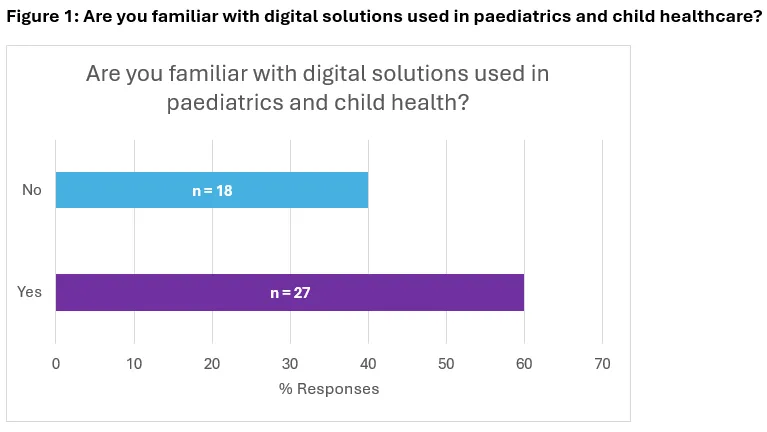
Contrastingly, when asked about whether they had used any digital health solutions in their clinical practice 31% of respondents had not used any digital solutions (Figure 2).
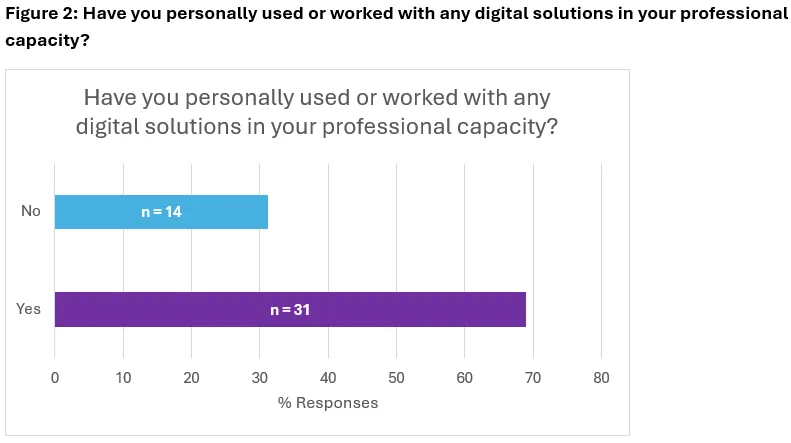
Perceptions of how effective digital solutions are in paediatrics and child health
The respondents were asked about their opinions on the effectiveness of digital health solutions in their work. The results from 40 responses found that 70% thought that solutions were either very effective or effective compared with 7.5% who reported that they were not effective in their work (Figure 3); however, a considerable 23% highlighted that digital solutions were mixed in their effectiveness.
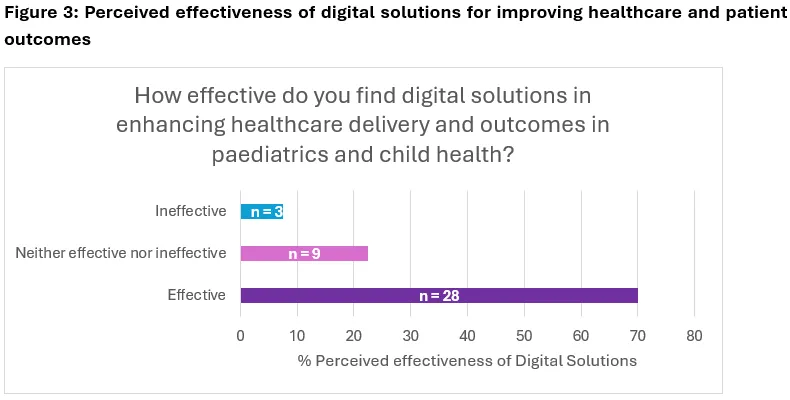
Overall, respondents’ views on the effectiveness of their mentioned digital health solutions varied and these were affected by their experiences of using them. The summary of the comments by the effectiveness rating is provided below in Table 1.
Table 1: Summary of respondents’ perceptions of the effectiveness of digital solutions in general
| Effectiveness rating | Number of comment responses | Summary of comments and related quotes |
|---|---|---|
| Very effective | 2 |
Digital solutions provide opportunities to optimally deliver healthcare “Great opportunities to enhance healthcare delivery as outlined” |
| Somewhat effective | 15 |
While digital solutions can enhance healthcare delivery, navigating between the different available platforms can be challenging and overwhelming: So many different platforms, not always easy to navigate. Can be overwhelming in terms of number of platforms/apps etc and therefore be a put off Technologies may have limited scope in that there are many solutions for specific purposes, and few created for multipurpose uses. The lack of interoperability between platforms also compounds this issue as well as lack of patient data sharing / access between platforms to aide speedier direct care. Limited scope so far and there is often a downside in that these solutions don't link to other platforms [the] biggest thing is access to GP data e.g. medication, prescription uptake and vaccination records, via our EPR additional : access to the patient's records in another hospital (includes notes and results)”For some respondent’s digital solutions provided a faster way to access patient data and retrieving records easier. The implementation and use of digital solutions is not always executed optimally and effectively. This requires better infrastructure and planning to optimise the use of solutions more effectively. There are technologies available today which should be implemented to make child health more integrated, efficient and up-to-date… Every hospital has at least 4-5 different systems to do basic every-day tasks, the systems don’t speak to each other, and no one actually knows how to work them.”“Great to have but only if works and trust has functioning (i.e. responsive and knowledgeable) IT department, which ours unfortunately does not” While digital solutions may be available, Trusts may lack engagement with these to use in practice, and therefore access to solutions is denied. A number of advances are available. Sadly very few Trusts engage with them, particularly if paediatric / neonatal specific. |
| Neither effective nor ineffective | 6 |
Support from healthcare Trusts for clinicians to use digital solutions is sometimes minimal, which inhibits the adoption of technologies at the user level even when warranted for. We have not been helped to move forward with digital solutions despite request. We are told to send website links for info about conditions and management (e.g. ADHD, ASD) but real life support is minimal Off-the-shelf digital solutions such as EPRs are not always tailored or set up for the paediatrics setting and therefore not used effectively. Use electronic health records in the acute setting. Not always set up for paediatrics |
| Somewhat ineffective | 2 |
Some digital solutions are not fit for purpose Variable. Some are great and helpful. Our online notes and records system of choice is SystmOne and it is not fit for purpose Lack of interoperability and too many systems to learn and use for different purposes. This is burdensome on the healthcare workforce. Too many separate software applications, apps etc. Nothing is very joined up. This can be frustrating for staff and is not what patients expect. Cumulatively a lot of time is lost as well. |
| Very ineffective | 0 | Nil |
The key benefits and challenges of using digital solutions
Short text responses were captured from respondents about the benefits and challenges of using digital health solutions in paediatrics. The key benefits identified for using digital solutions were categorised into 4 themes: 1) efficient record making and patient data access, 2) more convenient communication methods saving time, 3) supporting clinical decision-making and administration, 4) improving access to healthcare through home monitoring and care in the community.
The key challenges indicated 5 themes that were: 1) slow and outdated digital infrastructure hindering adoption of updated and innovative digital solutions, 2) digital healthcare inequalities, 3) poor procurement decisions and deployment planning, 4) lack of awareness of appropriate available digital solutions, 5) scarcity of information about effectiveness and evidence base of digital solutions.
Table 2 summarises the key benefits and challenges of adopting digital solutions.
Table 2: Summary of key benefits and challenges of using digital solutions in paediatric practice
| In your opinion, what are the key benefits of utilising digital solutions in paediatrics and child health? (32 responses) | What challenges or limitations do you perceive with current digital solutions? (35 responses) |
|---|---|
|
|
The barriers and facilitators of adopting digital solutions
Respondents were also asked about what would help or hinder the integration of digital technologies into clinical pathways and practice. Overall, the key facilitators to adopting digital technologies were captured in 6 themes: 1) Information and training provision for obtaining and maintaining digital skills, 2) having high quality digital solutions embedded in well-developed digital infrastructures, 3) ongoing IT support to deploy, monitor and maintain digital solutions tailored to paediatrics, 4) improved scrutiny of digital solutions for procurement, 5) increasing the confidence of decision-makers to adopt new technologies at national and local levels, and 6) more funding is needed for access to digital solutions and eliminating digital inequities.
The barriers to using novel digital health technologies were expressed across seven themes: 1) Poorly designed technologies and weak digital infrastructure, 2) paucity of digital access and funding for procuring technologies, 3) technological burden e.g. unlinked solutions, multiple-entry systems, and no IT support, 4) insufficient digital skills information and training, 5) lack of transparency of effectiveness of digital solutions and capture/use of patient data, 6) top-down decision making and lack of engagement with healthcare professionals / end -users, and 7) slow culture change.
Summaries of the responses are provided in Table 3.
Table 3: Summary of the barriers and facilitators to adoption of digital solutions in paediatric practice
| What do you need to help you introduce and integrate technologies and digital solutions into clinical pathways? (29 responses) | What would prevent you from using new health technologies in paediatrics and child health? (28 responses) |
|---|---|
|
|
Future digital perspectives
The final questions invited respondents to provide their thoughts on how digitalised paediatrics might look in the future. The first question related to what advancements in digital solutions should be sought and the second question asked what the future of paediatrics might entail for improving healthcare delivery and patient outcomes. A summary of responses is provided in Table 4.
Table 4: Summary of perspectives of the future of digital healthcare in paediatrics and child health
| What advancements or features would you like to see in future digital solutions for paediatrics and child health? (44 responses) | How do you envision the integration of emerging technologies (e.g., AI, virtual reality, remote monitoring) in improving healthcare for children? (25 responses) |
|---|---|
|
|
Popular digital technologies / frequency of mentions by type of digital technology / solution
The survey categorised 15 different types of digital health solutions and asked respondents to provide the names of the solutions they had used or were aware of within the categories. There were 141 mentions of digital health solutions across all technology categories, and from these there were 90 unique digital solutions found.
The top 10 most frequently mentioned solutions ranged from multiple-use digital platforms such as Healthier Together, vCreate, and Neomate, which covered information sharing, and provided healthcare information and guidance to both clinicians and parents/carers. Some solutions were repeated in different technology categories as they were multi-functional.
Table 5 shows the topmost cited digital solutions in the survey overall. Figure 4 is a pie chart showing the proportion of mentions of digital solutions by digital technology type.
Table 5: Top 10 most frequently cited digital solutions
| Digital solution | Overall citation frequency |
|---|---|
| Healthier Together | 8 |
| Attend Anywhere | 7 |
| vCreate | 7 |
| UpToDate | 5 |
| BNF/BNFc App | 4 |
| E-LfH | 3 |
| Medicines for Children | 3 |
| Neomate | 3 |
| Glucose Monitoring and insulin pumps | 3 |
| Badgernet | 2 |
Figure 4: Frequency of digital solutions mentioned by digital technology type
Can't see? Open figure 4 in new browser tab
Conclusion
The survey highlights growing engagement with digital health technologies in paediatrics, with many clinicians recognising their potential to improve care delivery and patient outcomes. However, challenges such as outdated infrastructure, limited interoperability, and digital inequalities remain. Addressing these barriers through better training, infrastructure, and co-designed solutions will be key to enabling safe, effective, and equitable digital transformation in child health.
For more information and to get involved in the Digital Health Programme, please contact Nisha Shah, RCPCH Digital Healthcare Manager: nisha.shah@rcpch.ac.uk.





